A FRAMING STATEMENT
‘In-between. A chance for you to sit, to think, to watch and to experience. A chance for you to give us your time and for us to give you our words.’ (Potente, Crawford, Sargent, 2016)
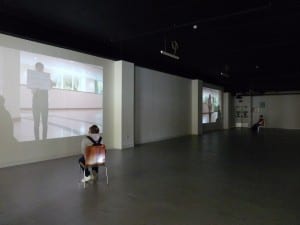
In-between was a live art multimedia performance which took place on the 6th May 2016 at the Waterside Shopping Centre Unit RU1 situated on the ground floor between H&M and Roman. The piece was a durational performance which ran from 12:00 until 16:30. The performance was open to the general public as well as having an invited audience of both Drama students and Lecturers. Over the course of the four and a half hours we ended up having between 25- 50 audience members some of which participated within the performance, others took more of a passive approach.
In-between was inspired by ethnography, which is the study of watching, as essentially the piece was watching passing people doing their day to day things. However, we played on this by creating a more intimate feel. 2 audience members were invited to sit on 2 chairs and then we (myself, James and Elliot) performed in a non-performative way by turning pages on placards. The words and phrases on the placards were emotive in a way which created an almost intimate performance for the audience members sat in the chair, as they felt we were connecting with themselves and only themselves. We created a dramatic feel without being dramatic at all. As performers we did ordinary things such as stand and wait but because we were doing this in an open and busy environment it became out of the ordinary.
Our piece was also heavily influenced by Michael Pinchbeck’s piece Sit with me for a moment and remember (Pinchbeck). As we wanted to mirror the intimacy which he created with the audience.
Pinchbeck also played with the concept of imagination, ‘close your eyes’ (Pinchbeck) which allowed audience members to imagine and create images of longing for something/ someone, where as we created a longing for someone using out emotive words.
We also created a cinematic feel with just projectors and cameras. As the space felt more gallery like, being that it had just been refurbished and painted white, the walls were perfect for projecting a clear image of the outside shopping centre into the space. As we found that with site specific performance it is not just the space around but everything outside and leading up to the space. Site specific performance spills and ruptures into the surrounding area.
AN ANALYSIS OF PROCESS
Week 1. My initial ideas. So after my first site lesson I felt so inspired and excited to create a piece of not just drama but a piece of art, that I went home and brainstormed many different ideas. First of all I thought about doing an almost art attack idea by creating a map of Lincoln entirely out of materials found amongst the high street. For instance elements of shops, bags, coat hangers etc. I also like the idea of bringing people together, bringing the community without the people of Lincoln necessarily knowing they were all part of something, much like Stephen Fossey’s piece where he brought and entire community within a block of flats together by inviting each of them to turn on their lights. Another idea which had been circulating my head, was writing you are here in the centre of either a mirror, or glass, or even paper. Then collecting words from the people of Lincoln. Furthermore, I felt that I could layer this performance with a sound scape of voices from recording the words from the people.
Week 2. Developing my concept. So within the workshop and seminar of week 2 we looked at place and non-place. According to Marc Augé, a French anthropologist, non-places are spaces of transit, ‘nothing meaningful or social can happen in a non-place’ as non-places are regarded as a waiting area for someone to pass through to be somewhere else. From this we each experimented with instructions which was loosely based on Carl Lavery’s article 25 instructions for performance in cities. (Lavery, 2005)
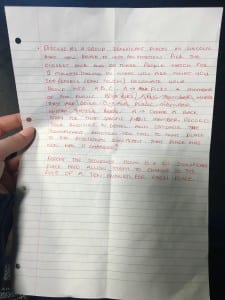
After following the instructions given to us by our pears, my group ended up at Lincoln train station where we sat, watched and waited for a while. After spending about 20 minutes within the train station site, I felt that it was no longer just a station where I waited but a place with so many stories from so many people. To me the train station is about my journeys to and from Lincoln, to others it’s a place of goodbye kisses.
Week 3. Let’s find a group and explore. Within week three we finally consolidated ideas amongst each other and organised ourselves into groups we then went off to explore our site, the city of Lincoln. After last week’s instruction and direction exercise I and my newly found group members decided to continue with experimenting. So we left LPAC and asked ‘Which way should we go?’ to the general public whenever we came to a junction. We often got laughed at or ignored but we also got some really interesting directions displayed below.
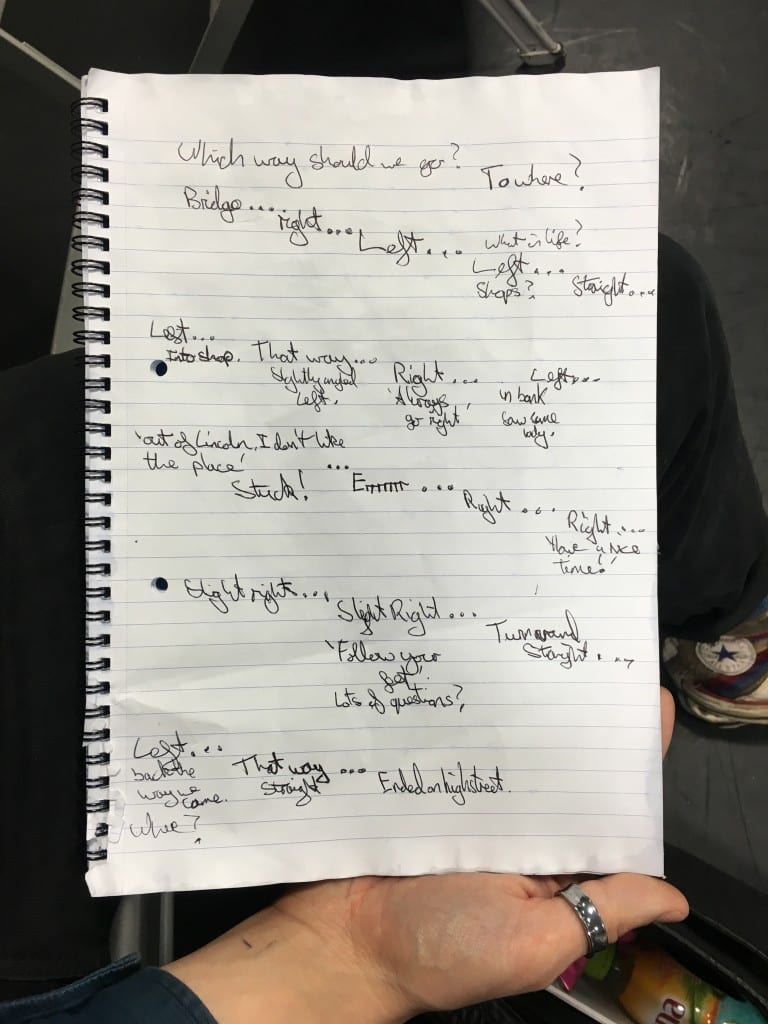
From this experiment, I found it really useful to see how much the general public were willing to get involved and this would later aid me in my site work.
Week 4. Experiment. Line drawing exercise- we went into pound land on the high street and purchased chalk and a chalk board. We then drew a line from the outside of pound land to the subway (as we ran out of chalk) we then left a sign at the entrance of the subway
What I loved about this experiment was the fact that all the public could see what we were doing yet once we had finished it was like it never happened. No one questioned why there was chalk on the floor and everyone just got on with their day to day lives.
Week 5. Find a site ASAP! As we were fast approaching Reading week, we took week five as a chance to cement where our site would be. I was heavily inspired by the frequency light festival that took place in the waterside in November 2015, where they transformed one of the shopping units into a light display. After explaining my interest to the rest of the group about having the performance within a unit rather than out on the high street, we all agreed that we needed to get in touch with waterside shopping centre and get in the unit! We also started to consolidate our ideas and looked at Adrian Howells site specific performance, Salon Adrienne (Howells, 2007).
We found it really interesting his use of a ritualistic confessional where words were simple exchanged. From this we decided that during our final performance we would set up our own confessional. Furthermore, during week 5, Elliot and I went to see A Machine they’re Secretly Building (Westerside, 2016) which eventually became a huge influence on our piece. We immediately fell in love with the idea of CCTV, mass surveillance, archiving and storing other people’s information. We felt that we could use the confessional concept from Adrian Howells and manipulate an audience into giving up their own information, to see how easy it would be as well as to make others aware that this is what’s happening every day.
Moreover, we looked at Fran Tonkiss’ book Space, the city and social theory and her concept of why not knowing everyone is a good idea. Linking it back to mass surveillance and everyone knowing everyone. Therefore I and Elliot took it upon ourselves to find out more about surveillance in Lincoln, we therefore took photos of CCTV cameras and places that show restriction. Once we had discussed it with James, we immediately thought why not set up shop in our site and sell the photos which we had taken but for free, playing with the lexis of free.
READING WEEK
Week 7. Let’s go live. So after a week’s break we went back into our space were we decided to do another experiment? This time using a live feed and social media. We went live on Facebook for all users to see.
Week 8. Bring it back to consumerism and archiving. After a week of discussing what we wanted to do, we realised that we had all gone off topic. We were in unit in a shopping centre but yet we had photographs of CCTV cameras, and there were no direct links between the two. Therefore we came up with the idea of having a camera in one of the shop windows with a monitor next to it saying ‘CCTV, smile your on camera.’ Emphasizing the fact that the public is being watched. Furthermore we then thought about this being projected onto the back wall of the space as part of an archive where information would be stored.
Week 9. The space is a shop. During week nine we needed to make the performance more site specific so we all thought about what is usually in a shop? Rails and mannequins. Because we were using a shopping unit we had to keep relating it back to the site. If we were to move the piece from the unit we needed to make sure it couldn’t be performed else were. If our work were to be moved it would make it irrelevant, as we are placing this work into the public’s everyday life – a shop. Taking the ‘shop’ out of it, gives too much of a performative meaning to the piece and places the audience on a level where they will have preconception and presumption of the performance. When the work is an actual shop the audience is able to be engaged with the piece on a passive level, but then are forced to question the realms of the ‘shop’ and in turn their everyday life. we also needed to take into consideration the other shop window which we did. I suggested blocking of the window like the shop is undergoing refurbishment, by doing this we could create a private space which would be separate from the outside world. Furthermore, if we made a tiny slit in the blocked of window we could create an intimate viewing area.
EASTER BREAK
Week 12. Gathering resources. Throughout week 12 we began to gather resources from shops on the high street such as Dorothy Perkins and New Look and begin to install them into the space so that we could get a real feel for the piece. we also decided that we should use music expressing freedom.
Week 13. 2 weeks to go. so within week 7 we had both our module leader, Conan and our module tutor Steve come to review the piece and give us improvements. As so as Conan walked into the space he said that it was a gallery and therefore when we explained, they both could see that we had far too much going on. We needed to simplify the idea as we’d lost the concept of the piece and the greatness of the space and site. Therefore we took the camera in the shop window and projection on wall and decided we could make something beautiful from something so simple.
Week 14. The final hurdle. we needed tech equipment and quick so that we could see how it worked within the space. Through correspondence with Darren Page we finalised the equipment we needed and successfully were able to obtain it for the day.
Week 15. Performance week.
PERFORMANCE EVALUATION
On the 6th May 2016 it was finally performance day. It was finally time to present the piece we had been working on, developing, simplifying and adapting over the past 15 weeks. Although we had never actually done the piece due to tech equipment not being available, I felt somewhat at ease that after everything it was finally time to show Lincoln what we had been working on. So after a late night preparing the placards and finalising tech equipment such as tripod and camera batteries, we all had a 9’o’clock start at LPAC. Once we had all arrived at the Waterside shopping Centre, I was informed by a member of security that the equipment which we were using had to be brought in through the delivery entrance rather than dragged through the shopping centre. This was due to health and safety reasons as the shopping centre was open to the general public. Once we had started to set up for a start time of 12:00, we became concerned of the lighting and the projectors.
Furthermore we had to put the projectors on the floor as we were not able to have them at a height due to not having the equipment and time to make it possible. However, this caused a shadow to appear in the frame from the chair. Although this was accidental, the shadow became a great asset to our piece, creating a different depth of performance allowing the audience member on the chair to actually become part of the performance as it looked as though they were in the frame.
So at 12:00pm the shutter to the store was open and our performance had officially started. We started off with two audience members both of which were Drama students and had been invited to watch the piece by ourselves. It then went considerably quiet not only within our piece but the shopping centre itself. I can only assume that this was due to it being lunchtime as well as it being considerably ‘nice’ weather outside. But then from nowhere it became noticeably busy again. This continued throughout the entire day, fluctuating numbers of the public. However, In-between seemed to be attracting quite a few people as a lot of the general public were very interested in what we were actually doing. During one part of the performance I had two audience members ask me what I was doing in which I explained it was a site performance for a module on Drama at the University of Lincoln, they responded with, “it’s sad to see empty shop units, makes towns and cities look run down. But you are using it in an exciting way. It’s something different. Good to see.”
Other audience members weren’t so interested in coming in the unit and viewing it instead they enjoyed the use of cameras in the shop window. Whilst our assessors were in we had a husband and wife playing with the cameras. The man pulled faces to the camera and was running in and out of shot where as his wife, still in shot, was laughing and telling him to stop. This for me created an innocent outlook on our piece. Yes we were creating an intimate performance for the 2 people on the chair, but we were creating something more for the passive audience. An almost technical playground allowing people to ‘act’ towards the camera or just pass by.
If we were to repeat In-between I personally feel would should make use of the shadows more, ‘I wish I could hold your hand’ was just one of the phrases where we could of made it so that the shadow created by the audience member could have reached out and grabbed the hand on the projection.
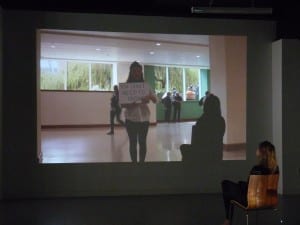
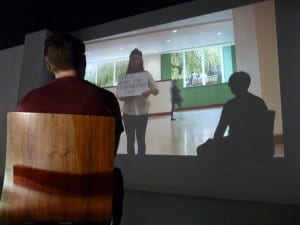
Furthermore I would have loved a bigger audience, so that more people could have taken a moment with us. I feel the smaller audience numbers were due to the fact that it was a warm Friday as well as the fact we had very little advertising for the general public.
In-between was, surprisingly to me, a great success. Even elements of the performance which had incidentally happened such as the soundscape created by the echoing space, music and noise from the shopping centre, created something special for our piece, something that if we were ‘to move the work is to destroy the work.'(Serra, 1994)
BIBLIOGRAPHY
Howells, A. (2007). Salon Adrienne.Available at: https://www.youtube.com/watch?v=mmUn2ZTzeY0 [Accessed 3 Mar. 2016].
Lavery, C. (2005). Teaching Performance Studies: 25 instructions for performance in cities. Studies in Theatre and Performance, 25(3), pp.229-238.
Pinchbeck, M. Sit with me for a moment and remember. [Online] Derby, Leicester, Manchester, Nottingham and Sheffield. Available at: https://blackboard.lincoln.ac.uk/bbcswebdav/pid-1155917-dt-content-rid-2084469_2/courses/DRA2035M-1516/DRA2035M-1516_ImportedContent_20150807123831/Sit%20with%20me%20for%20a%20moment%20and%20remember%20-%20Conan.mp3 [Accessed 18 Apr. 2016].
Potente, L. Crawford, J. Sargent, E. (2016) In-between. [Performance] Lincoln: Waterside Shopping Centre RU1, 6th May.
Tonkiss, F. (2005). Space, the city and social theory. Cambridge: Polity.